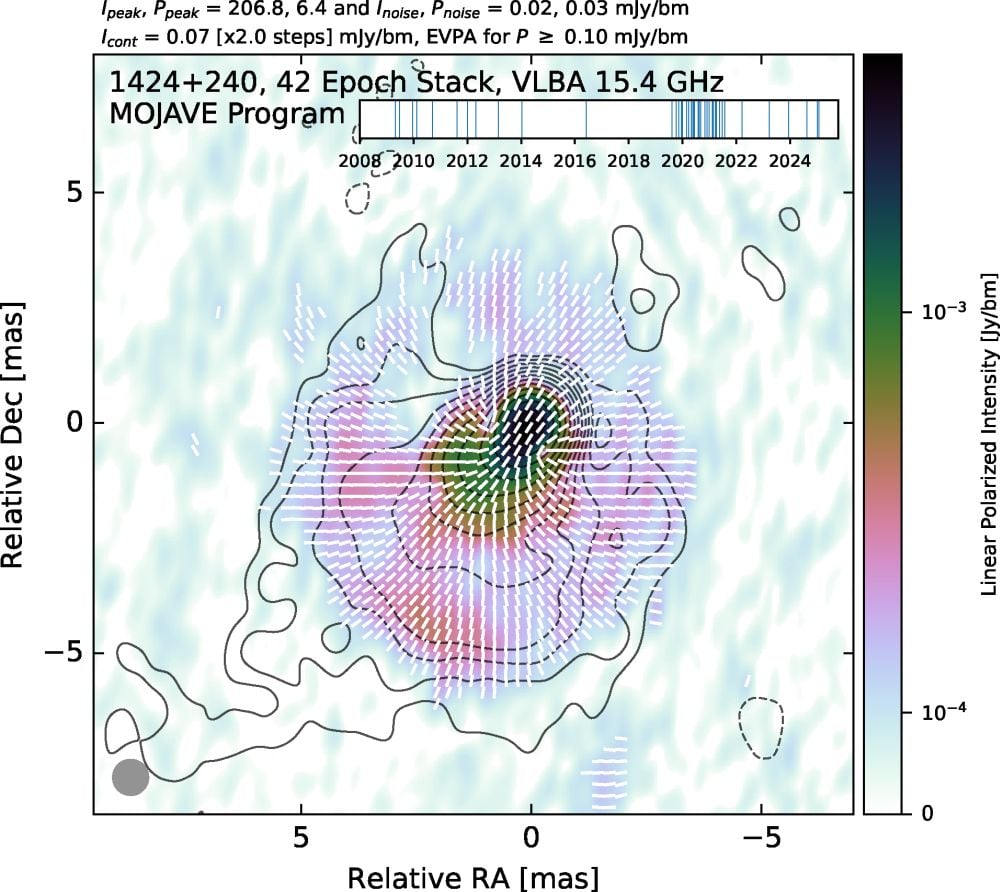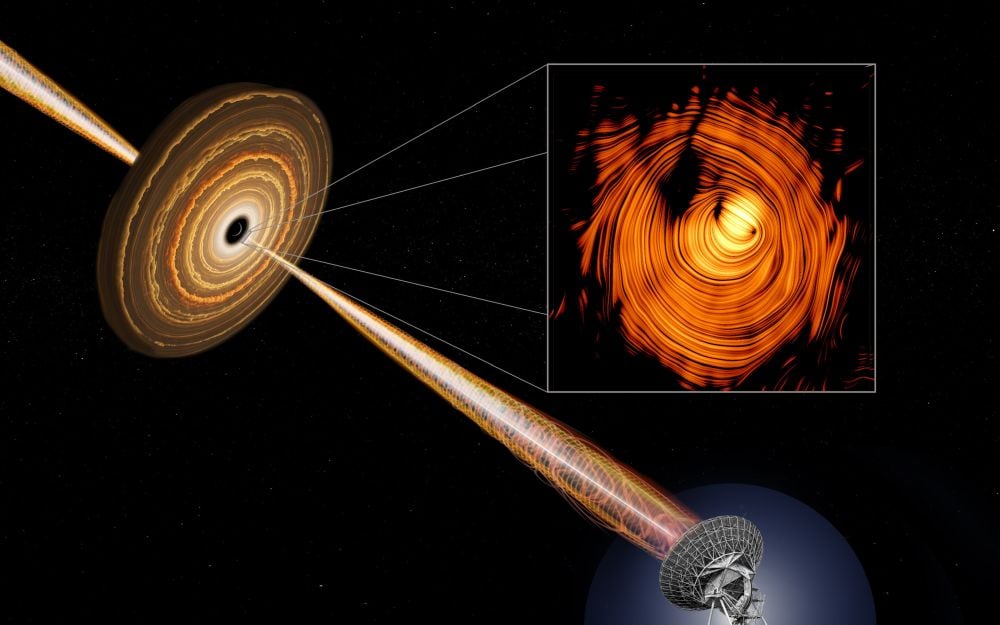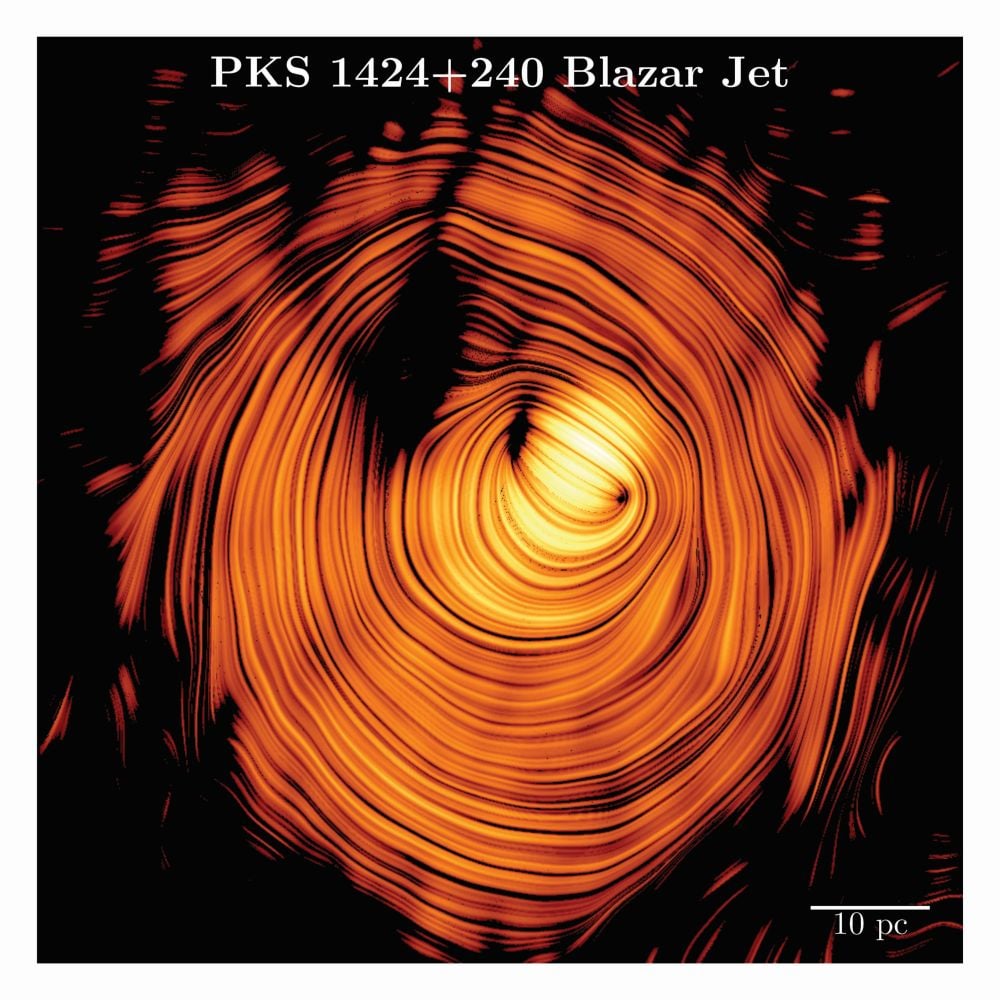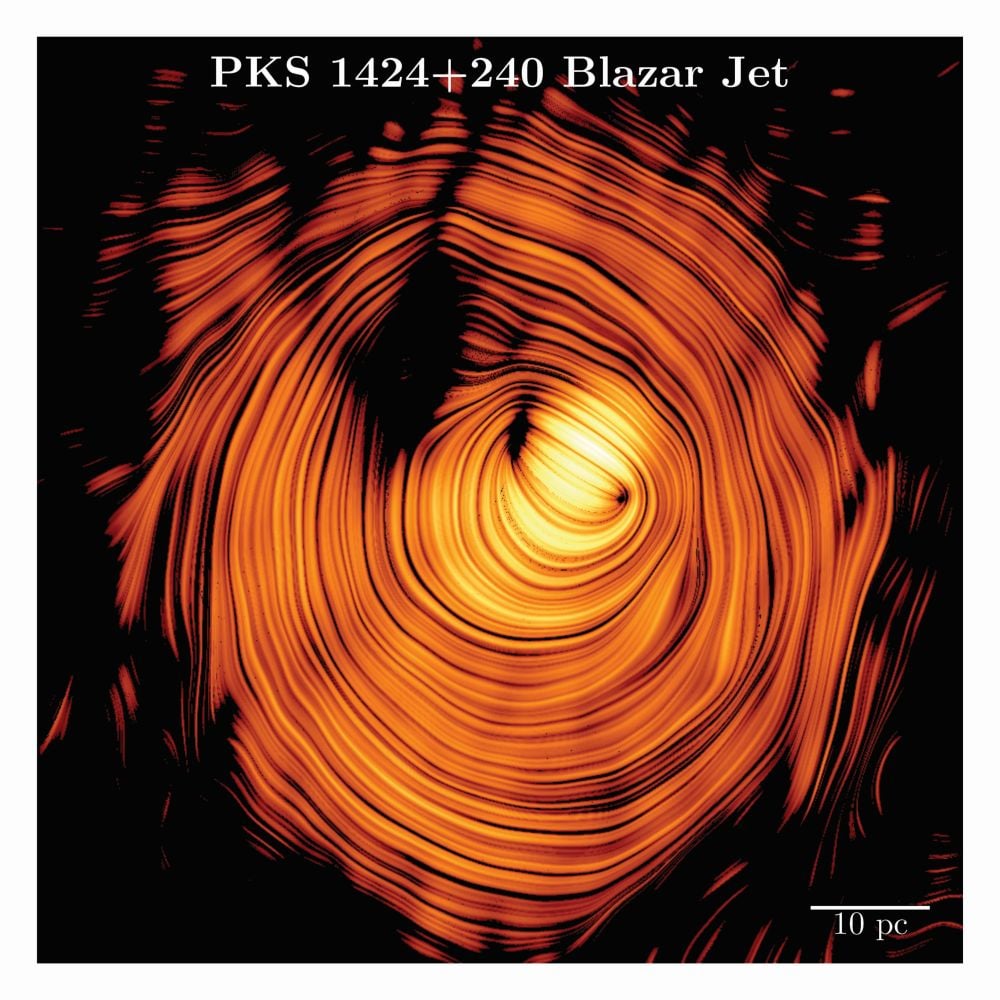All large galaxies are thought to host supermassive black holes (SMBH). When the black holes are actively accreting material and emitting radiation, astrophysicists call them active galactic nuclei (AGN). Some AGN emit relativistic jets, streams of ionized matter moving at near the speed of light. When those powerful jets are pointed at us, we call them blazars.
Blazars are extreme and enigmatic objects, and astrophysicists have unanswered questions about them. The mechanisms behind their jets are poorly understood. What role do magnetic fields play? How are particles in the jets accelerated so that they emit gamma rays? How do they emit neutrinos? Some jets extend for thousands of light years, yet are variable in timescales as short as a few minutes. What causes that?
Blazars are AGN that emit powerful jets of energetic, high-velocity particles aimed in our direction. They’re sometimes called Nature’s particle accelerators. Image Credit: Marscher et al., Wolfgang Steffen, Cosmovision, NRAO/AUI/NSF
New research in Astronomy and Astrophysics is providing an answer to one of the stubborn questions. It’s titled “Looking into the jet cone of the neutrino-associated very high-energy blazar PKS 1424+240.” The lead author is Yuri Kovalev, Principal Investigator of the MuSES project at the Max Planck Institute for Radio Astronomy (MPIfR). MuSES stands for Multi-messenger Studies of Extragalactic Super-colliders, and it’s aimed at probing the AGN jets to understand how they form, collimate, produce neutrinos, and accelerate particles.
PKS 1424+240 is a slow-moving blazar that could be one of the brightest sources of neutrinos and high-energy gamma rays ever found. It’s also called a BL Lacertae object, or simply BL Lac, after its prototype object BL Lacertae. Bl Lacs are known for “large-amplitude flux variability and significant optical polarization.” They’re also known for their almost featureless spectra, This sets them aside from other AGN that show emission lines from their hot gas.
PKS 1424+240 is billions of light-years away, and despite being the subject of lots of scientific inquiry, it’s still baffling. Despite the neutrinos and high-energy gamma photons it emits, its jet is rather slow. This goes against expectation that the fastest jets should be the most energetic and the brightest.
It’s taken 15 years, but astronomers using the Very Long Baseline Array (VLBA) in New Mexico have pieced together an image of the jet at the highest-resolution ever achieved.
 This figure is a VLBA stacked image for the blazar PKS 1424+240. The contours show the Stokes level, a way to quantify the polarity and intensity of electromagnetic radiation. Image Credit: Kovalev et al. 2025. A&A
This figure is a VLBA stacked image for the blazar PKS 1424+240. The contours show the Stokes level, a way to quantify the polarity and intensity of electromagnetic radiation. Image Credit: Kovalev et al. 2025. A&A
“When we reconstructed the image, it looked absolutely stunning,” lead author Kovalev said in a press release. “We have never seen anything quite like it—a near-perfect toroidal magnetic field with a jet, pointing straight at us.”
It turns out that the jet’s aligned almost perfectly with Earth, so its high-energy emissions are amplified. “Our observations uncover a rare scenario. The object is viewed inside the jet cone, very close to the axis of its relativistic jet, with a viewing angle of < 0.6°,” the authors explain in their research.
 Looking inside the plasma jet cone of the blazar PKS 1424+240 with a radio telescope of the Very Long Baseline Array (VLBA). The viewing angle is nearly perfect, allowing researchers to detect a toroidal magnetic field. Credit: NSF/AUI/NRAO/B. Saxton/Y.Y. Kovalev et al. 2025. A&A
Looking inside the plasma jet cone of the blazar PKS 1424+240 with a radio telescope of the Very Long Baseline Array (VLBA). The viewing angle is nearly perfect, allowing researchers to detect a toroidal magnetic field. Credit: NSF/AUI/NRAO/B. Saxton/Y.Y. Kovalev et al. 2025. A&A
“This alignment causes a boost in brightness by a factor of 30 or more,” explains Jack Livingston, a co-author at MPIfR. “At the same time, the jet appears to move slowly due to projection effects—a classic optical illusion.”
It takes a near perfect alignment to be able to peer right into the jet. Polarized radio signals from the jet let the researchers map the magnetic field’s structure, revealing that it’s likely toroidal. This structure may enable the jet to accelerate particles to such extremely high energies.
 In a nod to Tolkein, the object is called the “Eye of Sauron,” which is a potent symbol of Sauron’s power. The lines of linear polarization show how we’re looking almost directly into the jet’s cone. Image Credit: Kovalev et al. 2025. A&A
In a nod to Tolkein, the object is called the “Eye of Sauron,” which is a potent symbol of Sauron’s power. The lines of linear polarization show how we’re looking almost directly into the jet’s cone. Image Credit: Kovalev et al. 2025. A&A
“Solving this puzzle confirms that active galactic nuclei with supermassive black holes are not only powerful accelerators of electrons, but also of protons—the origin of the observed high-energy neutrinos,” concludes Kovalev. Accelerated protons don’t directly produce neutrinos, but they’re at the beginning of a chain of events that results in neutrinos.
This animation shows how the object has varied over 15 years of observations.
This research is a result of the NRAO’s MOJAVE (Monitoring Of Jets in Active galactic nuclei with VLBA Experiments) observing program. MOJAVE is a long-term program to observe AGN jets that vary in polarization and radio brightness. Some of its targets have been observed for 30 years. These results are exactly what MOJAVE was trying to accomplish.
“When we started MOJAVE, the idea of one day directly connecting distant black hole jets to cosmic neutrinos felt like science fiction. Today, our observations are making it real,” says Anton Zensus, Director at MPIfR and co-founder of the program.

